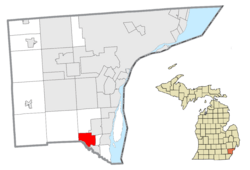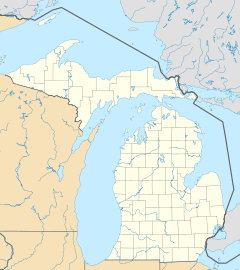Flat Rock, Michigan facts for kids
Quick facts for kids
Flat Rock, Michigan
|
||
|---|---|---|
| City of Flat Rock | ||

Flat Rock Municipal Building
|
||
|
||

Location within Wayne County
|
||
| Country | United States | |
| State | Michigan | |
| Counties | Monroe and Wayne | |
| Incorporated | 1923 (village) 1965 (city) |
|
| Government | ||
| • Type | Mayor–council | |
| Area | ||
| • City | 6.71 sq mi (17.37 km2) | |
| • Land | 6.55 sq mi (16.95 km2) | |
| • Water | 0.16 sq mi (0.42 km2) | |
| Elevation | 597 ft (182 m) | |
| Population
(2010)
|
||
| • City | 9,878 | |
| • Estimate
(2019)
|
10,004 | |
| • Density | 1,528.26/sq mi (590.07/km2) | |
| • Metro | 4,285,832 (Metro Detroit) | |
| Time zone | UTC−5 (EST) | |
| • Summer (DST) | UTC−4 (EDT) | |
| ZIP code(s) |
48134
48183 (Trenton) |
|
| Area code(s) | 734 | |
| FIPS code | 26-28360 | |
| GNIS feature ID | 0626146 | |
Flat Rock is a city mostly in Wayne County of the U.S. state of Michigan. A very small portion of the city extends into Monroe County. At the 2010 census, the city population was 9,878.
Contents
History
Flat Rock began as a Wyandot settlement. It was later designated as a reservation for the Wyandot, and still functioned as such in 1830.
The first Euro-American settlers in Flat Rock were Michael Vreeland and his five grown sons between 1811 and 1820. Michael had been captured by British Rangers during the Revolutionary War and released after American independence. The family purchased 800 acres (3.2 km2). The town was called the Village of Vreeland until 1838 when the Vreeland family sold off the majority of the land and relinquished control of the area. The Vreeland families built the first grain and lumber mill, having brought the grinding stones from New York. Descendants of Michael Vreeland still live in the town and attend Flat Rock public schools, being the seventh generation to reside in the town their family founded.
The first mention of any settlers in the area later to become Flat Rock was made by a French priest, Father Jean Dilhet. In describing his parish in 1798 he included "Grosse Roche", referring to a settlement named after the outcropping of limestone rock on the south side of the Huron River.
In 1818, a land office opened in Detroit, and Soloman Sibley purchased 330.93 acres (1.3392 km2) of land. In 1824 it was sold to Michael and Jacob Vreeland. The villages of Vreelandt and Smooth Rock were platted on part of this acreage. At this time there were Huron, Seneca, and Wyandot Indian villages in the area.
With the opening of the Erie Canal in 1825, large numbers of people, especially from New York, came to Michigan to settle. By 1828 the village had four stores, two saw mills, a wood carding mill, a flour mill, and 250 inhabitants - serving as a center mainly for farmers who lived in the area immediately surrounding the settlement.
The village of Flat Rock was platted and recorded in 1838 by the Gibraltar and Flat Rock Land Co. They were attempting to build a canal to connect Lake Erie with Lake Michigan. This effort ultimately failed.
Henry Ford was attracted to the water power of the Huron River, and in 1925 he established the Ford Motor Company Lamp Factory along its banks.
The area was incorporated as a village in 1923 and as a city in 1965. While Flat Rock is a rapidly growing community today, even with its growth, it remains a unique "small town" with many of its residents having roots reaching back to the 1800s.
From the 1930s until the early 1960s an airport was located in Flat Rock. The grass airfield was known as Nan-Bar Airport, named for the owner's two daughters, Nancy and Barbara. During World War II Nan-Bar Airport served as an accessory airfield for Naval Air Station Grosse Ile. Navy pilots used the airfield for short field landing instruction, as well as for emergency landings.
Flat Rock's massive growth from a small village to a medium-sized suburb began with the construction of Huron River Estates from 1953-1954.
Geography
According to the United States Census Bureau, the city has a total area of 6.67 square miles (17.28 km2), of which 6.53 square miles (16.91 km2) is land and 0.14 square miles (0.36 km2) is water. The city is primarily within Wayne County, but a portion of the city lies in Monroe County, because the border along the Huron River follows the course of the river in 1923, the year Flat Rock was incorporated as a village. At the time, the river had two meanders, but they have since been filled in.
Demographics
| Historical population | |||
|---|---|---|---|
| Census | Pop. | %± | |
| 1880 | 373 | — | |
| 1930 | 1,231 | — | |
| 1940 | 1,467 | 19.2% | |
| 1950 | 1,931 | 31.6% | |
| 1960 | 4,696 | 143.2% | |
| 1970 | 5,643 | 20.2% | |
| 1980 | 6,853 | 21.4% | |
| 1990 | 7,290 | 6.4% | |
| 2000 | 8,488 | 16.4% | |
| 2010 | 9,878 | 16.4% | |
| 2019 (est.) | 10,004 | 1.3% | |
| U.S. Decennial Census | |||
2010 census
As of the census of 2010, there were 9,878 people, 3,754 households, and 2,684 families living in the city. The population density was 1,512.7 inhabitants per square mile (584.1/km2). There were 3,995 housing units at an average density of 611.8 per square mile (236.2/km2). The racial makeup of the city was 91.1% White, 4.1% African American, 0.5% Native American, 0.8% Asian, 0.6% from other races, and 2.9% from two or more races. Hispanic or Latino of any race were 4.4% of the population.
There were 3,754 households, of which 38.9% had children under the age of 18 living with them, 49.8% were married couples living together, 16.6% had a female householder with no husband present, 5.1% had a male householder with no wife present, and 28.5% were non-families. 23.6% of all households were made up of individuals, and 8.1% had someone living alone who was 65 years of age or older. The average household size was 2.62 and the average family size was 3.10.
The median age in the city was 36.9 years. 27.4% of residents were under the age of 18; 8.4% were between the ages of 18 and 24; 26.6% were from 25 to 44; 27.1% were from 45 to 64; and 10.4% were 65 years of age or older. The gender makeup of the city was 48.1% male and 51.9% female.
Community growth
In the last 10 years Flat Rock has grown from a sleepy suburb on the fringes of Wayne County to a booming development area. Property values have substantially increased and population in the next census is also expected to increase. New construction projects begun or completed since 2000 include:
- Flat Rock Playscape
- Flat Rock High School
- Flat Rock Community Baseball Complex
- Downriver Linked Greenways
- Flat Rock Fountain/Ice Skating Rink
- Flat Rock Community Recreation Center
- Condominiums
- High School Track and football field bathrooms
Miscellaneous data
Flat Rock has a higher overall tornado average than the state of Michigan as a whole, and a 66% greater average than the United States as a whole. Two F4 tornadoes have hit Flat Rock - one in 1956, another in 1965 resulting in 23 deaths and over 300 injuries.
Flat Rock is the childhood hometown of Dann Florek, who plays Captain Donald Cragen in the television series Law & Order and Law & Order: Special Victims Unit.
Specific
General
 |
Huron Charter Township | Brownstown Charter Township, Woodhaven | Trenton |  |
| Gibraltar | ||||
| Ash Township | Rockwood Berlin Charter Township, South Rockwood |
Brownstown Charter Township |
Economy
In December 2019 Flat Rock had an unemployment rate of 6.5%, higher than the US average of 3.7%. Per capita income in Flat Rock was $27,549, below the US average of $31,177. The average household income was $63,375, above the US average of $57,652. The family median income was $76,481, above the US average of $70,850.
Education
Flat Rock is served by Flat Rock Community Schools.
Notable people
- Dann Florek, actor
See also
 In Spanish: Flat Rock (Míchigan) para niños
In Spanish: Flat Rock (Míchigan) para niños




